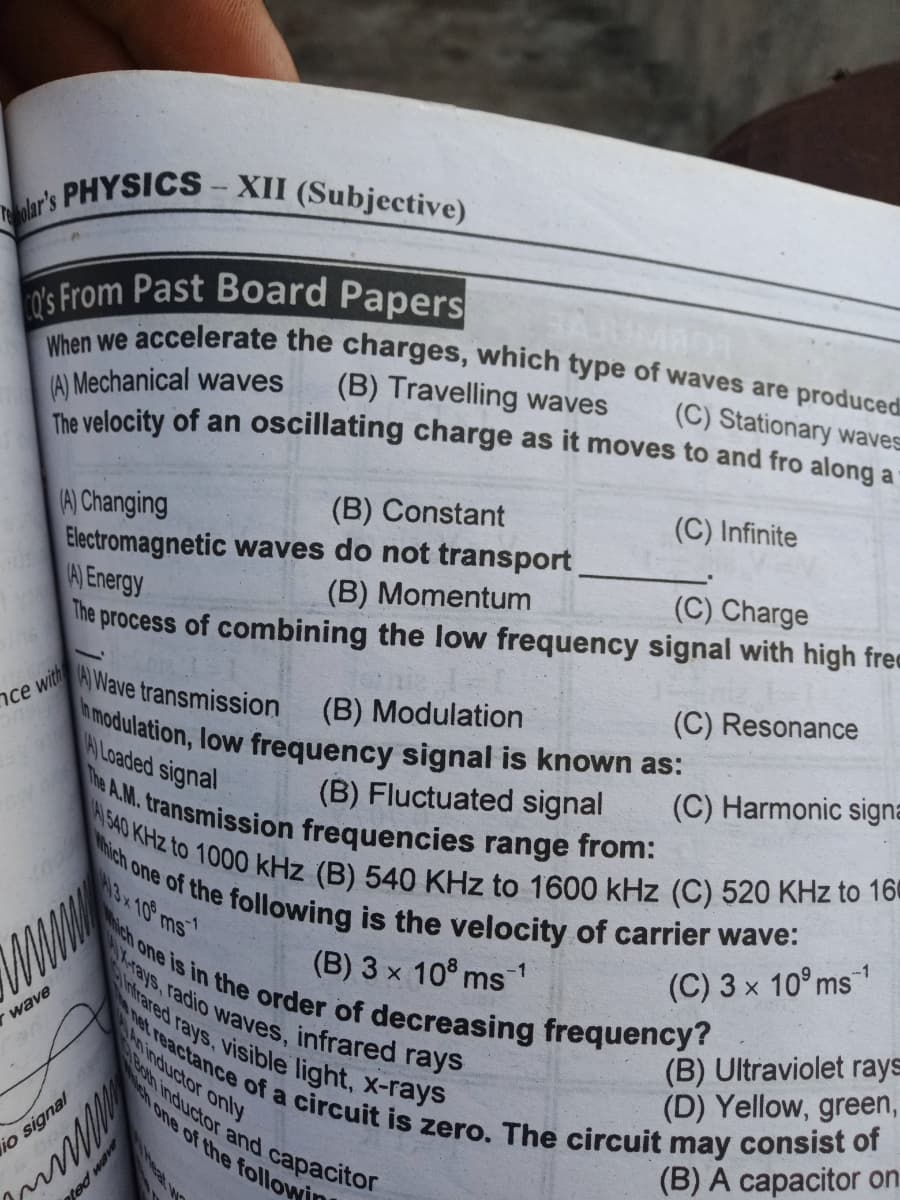When we accelerate the charges, which type of waves are produced (A) Mechanical waves The velocity of an oscillating charge as it moves to and fro alon (B) Travelling waves (C) Stationary waves
When we accelerate the charges, which type of waves are produced (A) Mechanical waves The velocity of an oscillating charge as it moves to and fro alon (B) Travelling waves (C) Stationary waves
College Physics
11th Edition
ISBN:9781305952300
Author:Raymond A. Serway, Chris Vuille
Publisher:Raymond A. Serway, Chris Vuille
Chapter21: Alternating-Current Circuits And Electromagnetic Waves
Section: Chapter Questions
Problem 49P: The U.S. Navy has long proposed the construction of extremely low frequency (ELF waves)...
Related questions
Question

Transcribed Image Text:amodulation, low frequency signal is known as:
The AM. transmission frequencies range from:
ich one is in the order of decreasing frequency?
lar's PHYSICS- XII (Subjective)
ca's From Past Board Papers
A 540 KHz to 1000 kHz (B) 540 KHz to 1600 kHz (C) 520 KHz to 16
net reactance of a circuit is zero. The circuit may consist of
When we accelerate the charges, which type of waves are produced
hich one of the following is the velocity of carrier wave:
Intrared rays, visible light, x-rays
K-rays, radio waves, infrared rays
e From Past Board Papers
(B) Travelling waves
(A) Mechanical waves
The velocity of an oscillating charge as it moves to and fro along a
(C) Stationary waves
(B) Constant
(C) Infinite
A) Changing
Electromagnetic waves do not transport
A) Energy
The
(B) Momentum
(C) Charge
process of combining the low frequency signal with high fre
nce with
A)Wave transmission
(C) Resonance
(B) Modulation
A Loaded signal
(B) Fluctuated signal
(C) Harmonic signa
13x10 ms
--1
(B) 3 x 10 ms
(C) 3 x 10° ms
-1
(B) Ultraviolet rays
(D) Yellow, green,
wave
n inductor only
nductor and capacitor
one of the follow
(B) A capacitor on
io signal
Meal w
BADM peju
Expert Solution
This question has been solved!
Explore an expertly crafted, step-by-step solution for a thorough understanding of key concepts.
Step by step
Solved in 2 steps with 2 images

Knowledge Booster
Learn more about
Need a deep-dive on the concept behind this application? Look no further. Learn more about this topic, physics and related others by exploring similar questions and additional content below.Recommended textbooks for you

College Physics
Physics
ISBN:
9781305952300
Author:
Raymond A. Serway, Chris Vuille
Publisher:
Cengage Learning

College Physics
Physics
ISBN:
9781285737027
Author:
Raymond A. Serway, Chris Vuille
Publisher:
Cengage Learning


College Physics
Physics
ISBN:
9781305952300
Author:
Raymond A. Serway, Chris Vuille
Publisher:
Cengage Learning

College Physics
Physics
ISBN:
9781285737027
Author:
Raymond A. Serway, Chris Vuille
Publisher:
Cengage Learning


College Physics
Physics
ISBN:
9781938168000
Author:
Paul Peter Urone, Roger Hinrichs
Publisher:
OpenStax College

Glencoe Physics: Principles and Problems, Student…
Physics
ISBN:
9780078807213
Author:
Paul W. Zitzewitz
Publisher:
Glencoe/McGraw-Hill

Principles of Physics: A Calculus-Based Text
Physics
ISBN:
9781133104261
Author:
Raymond A. Serway, John W. Jewett
Publisher:
Cengage Learning